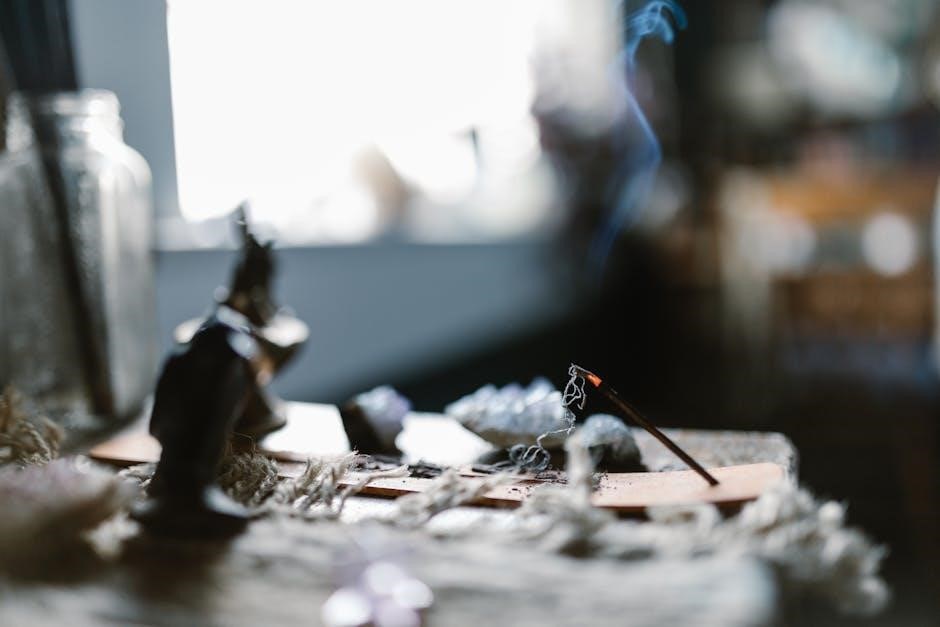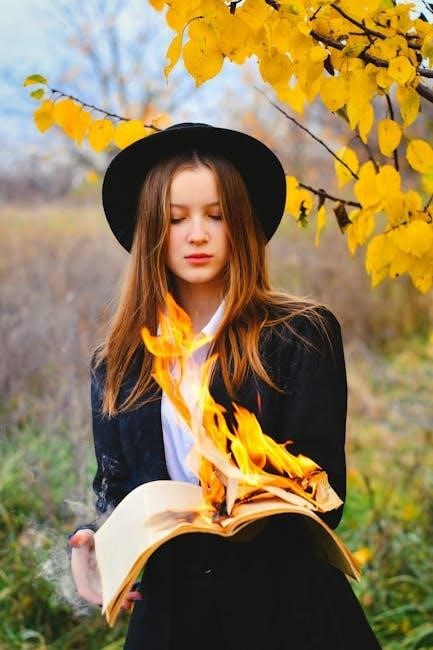A Witch’s Guide to Burning: An Overview
Witches were seen as evil beings by early Christians‚ shaping Halloween
figures. The history is dark‚ often deadly‚ with accused witches confessing
under torture. Witch hunts led to executions‚ often by burning.

Historical Context of Witch Burning
From 1400-1775‚ approximately 100‚000 people faced witchcraft prosecutions
in Europe and British America. Witch hunts peaked from 1560-1630. Burning
at the stake was used for heresy. The history of witches is complex.
European Witch Hunts (1400-1775)
During the early modern era‚ from approximately 1400 to 1775‚ Europe and
British America witnessed the prosecution of around 100‚000 individuals
for witchcraft. These witch hunts‚ prevalent across the continent‚ resulted
in the execution of an estimated 40‚000 to 60‚000 people‚ predominantly
within Europe itself. The severity of these persecutions was particularly
pronounced in regions encompassed by the Holy Roman Empire. These hunts
were fueled by superstition‚ religious tensions‚ and social anxieties‚
leading to widespread accusations and trials. Single women‚ widows‚ and
those on society’s margins were especially vulnerable.
Peak of Witchcraft Prosecutions (1560-1630)
The period between 1560 and 1630 marked the zenith of witchcraft
prosecutions in Europe. This era‚ coinciding with the Counter-Reformation‚
witnessed an alarming surge in witch hunts. Religious upheaval‚ political
instability‚ and social anxieties contributed to the heightened fear of
witchcraft. Accusations spread rapidly‚ often fueled by personal rivalries
and disputes within communities. The publication of texts like the Malleus
Maleficarum further intensified the witch mania. Executions‚ frequently
involving burning at the stake‚ became commonplace. During this time‚
thousands of individuals‚ primarily women‚ were accused‚ tried‚ and
convicted of witchcraft‚ leaving a dark stain on European history.

Methods of Execution: Burning at the Stake
Burning at the stake was a common execution method for accused witches‚
particularly in Europe. It was a public spectacle intended to deter others
and purify the land.
Burning as Punishment for Heresy
Burning at the stake was not exclusively reserved for those accused of
witchcraft. It served as a prominent form of execution for individuals
convicted of heresy against the established church. This punishment was rooted
in the belief that heresy was a spiritual disease that needed to be purged
from the community through fire. The act of burning was seen as a symbolic
cleansing‚ purifying both the heretic and the society they threatened.
Therefore‚ figures like Galileo‚ Luther‚ or Gutenberg faced the risk of being
burned for dissenting beliefs.
The Malleus Maleficarum and its Influence
Published in 1486‚ the Malleus Maleficarum‚ or “Hammer of Witches‚”
fueled witch hunts. It labeled witchcraft as heresy‚ becoming a guide for
identifying‚ hunting‚ and interrogating suspected witches across Europe.
A Guide to Identifying and Hunting Witches
The Malleus Maleficarum served as a detailed guide‚ outlining methods to
identify‚ interrogate‚ and prosecute suspected witches. It described physical
characteristics‚ behaviors‚ and vulnerabilities believed to be associated
with witchcraft. The book advocated for torture to extract confessions‚
presuming guilt and justifying extreme measures. It instructed authorities on
legal procedures‚ evidence gathering‚ and punishments. The text fueled
paranoia by promoting the idea of a widespread conspiracy of witches
collaborating with the Devil. It provided a framework for witch hunts‚
contributing to the persecution and execution of thousands across Europe.

Salem Witch Trials and Misconceptions
In Salem‚ Massachusetts‚ accusations of witchcraft spread rapidly‚ leading to
trials. Mass hysteria ensued‚ with young women exhibiting strange symptoms.
Accusations led to convictions and executions‚ revealing the dangers of
superstition.
Hanging vs. Burning in Salem
The Salem Witch Trials are often associated with burning at the stake‚ but
this is a misconception. In Salem‚ the primary method of execution was
hanging. Bridget Bishop was the first to be hanged at the Salem gallows.
Nineteen individuals were hanged for witchcraft in 1692. One man was pressed
to death by stones. Burning was more common in Europe. The myth of burning
in Salem likely stems from European witch trials‚ where burning was used.
The use of hanging reflected English common law practices prevalent in the
colonies‚ rather than continental European traditions.

Modern Perspectives on Witchcraft
Modern witches‚ often Wiccans‚ avoid evil and strive for peace‚ tolerance‚
and balance. Their spells are like prayers‚ used to prevent harm and
promote healing‚ differing greatly from historical stereotypes.
Wicca and Contemporary Witchcraft Practices
Modern-day witches of the Western World still struggle to shake their
historical stereotype. Most practice Wicca‚ an official religion in the
United States and Canada. Wiccans avoid evil and the appearance of evil at
all costs. Their motto is to harm none‚ and they strive to live a peaceful‚
tolerant and balanced life in tune with nature and humanity. Many
modern-day witches still perform witchcraft‚ but there’s seldom anything
sinister about it. Their spells and incantations are often derived from
their Book of Shadows‚ a 20th-century collection of wisdom and witchcraft‚
and can be compared to the act of prayer in other religions.
Witch Hunts in the Modern World
Witches still face persecution and death today. Violence against those
accused of witchcraft occurs in Papua New Guinea‚ Africa‚ South America‚ the
Middle East‚ and immigrant communities in Europe and the United States.
Continued Persecution and Violence
Despite historical narratives suggesting witch hunts are relics of the past‚
the persecution and violence against accused witches persist in the modern
world. Several men and women suspected of witchcraft have faced brutal
attacks and killings in various regions. In Papua New Guinea‚ incidents of
beatings and fatal burnings‚ including a young mother burned alive‚ have been
reported since 2010. Similar acts of violence against individuals accused of
witchcraft continue to occur in parts of Africa‚ South America‚ the Middle
East‚ and even within immigrant communities in Europe and the United States‚
highlighting the ongoing dangers faced by those labeled as witches.
Notable Cases and Accusations
Examining specific cases‚ like Bridget Bishop’s execution in the Salem Witch
Trials and Grace Sherwood’s water test‚ reveals the tragic consequences of
witchcraft accusations throughout history.
Bridget Bishop and the Salem Witch Trials
Bridget Bishop holds the unfortunate distinction of being the first person
executed during the infamous Salem Witch Trials in 1692. Accused of
witchcraft‚ she faced a court fueled by mass hysteria and spectral evidence.
On June 10th‚ she was hanged at the Salem gallows‚ marking a dark chapter in
American history. Her trial‚ like others during the period‚ was marred by
questionable testimonies and a climate of fear‚ highlighting the dangers of
unchecked accusations. Bishop’s case serves as a stark reminder of the
injustices perpetrated during the witch hunt era‚ revealing the devastating
impact on individuals and communities.
Grace Sherwood: The Witch of Pungo
Grace Sherwood‚ known as the Witch of Pungo‚ faced accusations of witchcraft
in Virginia during the early 18th century. Unlike many accused‚ she avoided
execution‚ although she endured significant hardship. Subjected to a water
test‚ she floated‚ deemed guilty by the standards of the time. Instead of
being killed‚ she was imprisoned for eight years. Sherwood’s story reflects
a less frantic approach to witchcraft accusations compared to other colonies.
Her case highlights the varied experiences of those accused‚ showcasing
different legal and social responses to witchcraft beliefs. Despite
accusations of harming livestock and crops‚ she survived the ordeal‚
becoming a lasting figure in Virginian folklore.